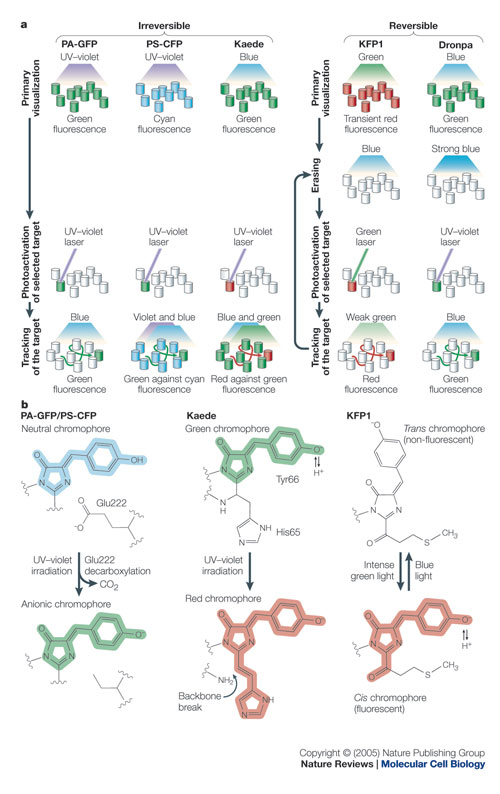 |
| Previous Image | Next Image |
| Description: Procedures for selective photolabelling using irreversible and reversible photoactivatable fluorescent proteins (PAFPs). Cylinders represent an object, such as a cell, organelle or protein, that has been tagged with a PAFP, and the cylinders are coloured according to the emission colours before and after photoactivation. The excitation or activating light is shown above the cylinders as coloured trapezuims or lines respectively. Only reversible activation is shown for KFP1 for simplicity (KFP1 is capable of both reversible and irreversible photoactivation depending on the intensity and duration of the activating light). b | Chromophore photoconversion mechanisms for PA-GFP and PS-CFP (decarboxylation of Glu222 followed by chromophore conversion from a neutral to anionic state), Kaede (breakage of the polypeptide backbone and formation of an extra chromophore double bond), and KFP1 (probably trans–cis chromophore isomerization). The coloured shading of the chemical structures correspond to the spectral range of chromophore emission (PS-CFP in the left panel; the trans form of KFP1 is non-fluorescent in the right panel). The protonation–deprotonation equilibrium shown for Kaede and KFP1 is important for their photochemical behaviour. In both cases, the protonated chromophore can undergo photoconversion, whereas the deprotonated chromophore determines the fluorescent properties of the protein. KFP1, kindling fluorescent protein-1; PA-GFP, photoactivatable green fluorescent protein; PS-CFP, photoswitchable cyan fluorescent protein; UV, ultraviolet. From: Nature.com Picture Stats: Views: 811 Filesize: 74.83kB Height: 794 Width: 500 Source: https://biology-forums.com/index.php?action=gallery;sa=view;id=19106 |
